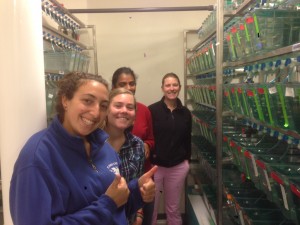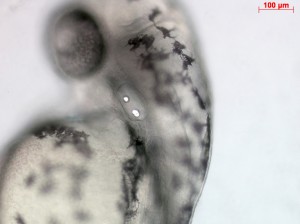Blog post from Nabil Saleem ’15
The first two weeks of my summer here at MDIBL have been interesting to say the least.
Apart from doing a lot of things I normally don’t do (including but not limited to hiking up to beautiful mountain tops and swimming in bodies of water in National Parks), I’ve also learned loads of information about zebrafish development and embryogenesis. And it’s only been two weeks! I can attribute a lot of that to our lab PI, Larissa Williams. She explained that instead of jumping into the fun lab work on day one, we would have to research primary literature for the first full week, something my fellow colleagues and I were not incredibly excited about. However, after a week of scouring primary literature and preparing a presentation, we learned more about zebrafish development than we could have imagined. This had the added benefit of making sure that we understood the science behind what we’re doing this summer. Anyone can pipette small volumes of liquid in petri dishes and tubes and pretend like they know what they’re doing, and they may get away with it too. But the real fun is actually knowing what you’re doing when you make up those solutions and when you expose zebrafish to certain treatments. Ironically enough, that first week of pretty tedious and somewhat dense research is actually leading to us having more fun in lab, now that we have a greater understanding for what we’re doing.
In a nutshell, our experiment centers on what types of deformities certain pro-oxidants induce in zebrafish. Interestingly enough, some of these chemicals are even in the food we eat, albeit in much smaller quantities. This week (week 2), we learned how to breed zebrafish and formed our hypotheses on what we may see once we expose our embryos to these pro-oxidants.
We also learned how to manipulate zebrafish embryos under our stereoscopic microscope for proper picture taking, something we’ll be doing a lot to determine the effects of our treatments on our embryos.
Bar Harbor is beautiful, and weekends have been filled with getting to know all sorts of undergrads from different places who all share the same passion of science that you do. I’m sure that along with plenty of hikes and plenty of kayak trips, there is plenty of great science to follow in the next few weeks!

